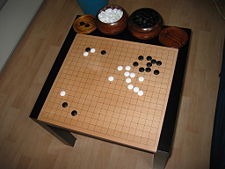Go (board game)
Go is a board game played by two players. It is also referred to as Weiqi in Chinese (圍棋; 围棋), Baduk in Korea (바둑) and Igo or Go in Japanese (囲碁; 碁). Go is the worlds oldest game that is played in its original form, with a documented history of over 2.500 years.
Character
Go is played on a flat board with a grid of 19x19 intersections. Two sets of white and black stones are used. The game is played in turns and unlike Chess, black makes the first move in go. Each stone is placed on an intersection and the goal is to capture more territory than the opponent. Go is one of the most complex games in the world, far outweighing games such as chess in the number of possible game positions. In go, it often matters whether a given move is beautiful or produces good shape.
History
There is no exact date for the invention of Go. One legend dates the invention to the Emperor Yuo who taught the game to his eldest son Dan Zhu. Most modern writers think, that this legend (and a few similar legends), were written down in the Han period, to make the game appear older than it really is. They date the invention to 1000-400 BC.[1]
Comparison to chess
Compared to chess go recquires more activation in the right parietal brain areas.[2]
Major Titles
There are 7 major go titles in Japan. The record for winning the most titles over the years is held by Japanese professional Cho Chikun, who has won 71 titles.
| Tournament | Prize money | Current title holder |
|---|---|---|
| Judan | Cho Chikun | |
| Tengen | Kono Rin | |
| Oza | Yamashita Keigo | |
| Meijin | Takao Shinji | |
| Gosei | Cho U | |
| Honinbo | Takao Shinji | |
| Kisei | Yamashita Keigo |
Cultural Dimensions
Go strategy is also studied as an metaphor for Asian strategy compared to western strategy.[3]
See also
External Links
Go Associations
- European Go Associantion
- Nihon Kin - Japanese Go Association
- International Go Association
- American Go Association
- Korean Go Association
Notes and references
- ↑ [http://www.usgo.org/resources/downloads/originsofgo.pdf The Game of Go Speculations on its Origins and Symbolism in Ancient China By Peter Shotwell]
- ↑ [http://www.sciencedirect.com/science?_ob=ArticleURL&_udi=B6SYV-46YJ540-4&_coverDate=03%2F31%2F2003&_alid=82770164&_rdoc=1&_fmt=&_orig=search&_qd=1&_cdi=4844&_sort=d&view=c&_acct=C000050221&_version=1&_urlVersion=0&_userid=10&md5=8b624f42de7fab3d239e9b6704715b26 A functional MRI study of high-level cognition II. The game of GO by Xiangchuan Chen et al]
- ↑ Learning from the Stones: A Go Approach to Mastering China's Strategic Concept, Shi, by Dr. David Lai
